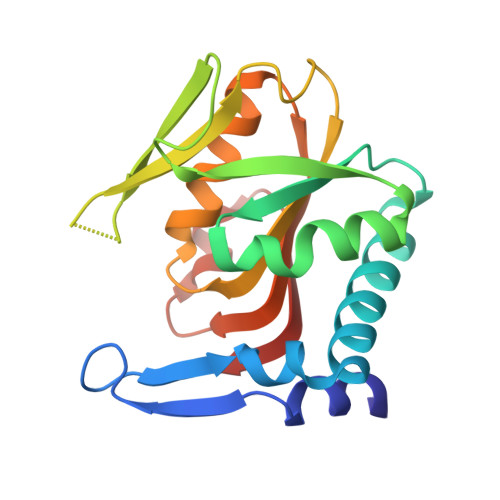Structural Insights into the Forward and Reverse Enzymatic Reactions in Human Adenine Phosphoribosyltransferase.
Huyet, J., Ozeir, M., Burgevin, M.C., Pinson, B., Chesney, F., Remy, J.M., Siddiqi, A.R., Lupoli, R., Pinon, G., Saint-Marc, C., Gibert, J.F., Morales, R., Ceballos-Picot, I., Barouki, R., Daignan-Fornier, B., Olivier-Bandini, A., Auge, F., Nioche, P.(2018) Cell Chem Biol 25: 666-676.e4
- PubMed: 29576532
- DOI: https://doi.org/10.1016/j.chembiol.2018.02.011
- Primary Citation of Related Structures:
6FCH, 6FCI, 6FCL, 6FD4, 6FD5, 6FD6 - PubMed Abstract:
Phosphoribosyltransferases catalyze the displacement of a PRPP ¦Á-1'-pyrophosphate to a nitrogen-containing nucleobase. How they control the balance of substrates/products binding and activities is poorly understood. Here, we investigated the human adenine phosphoribosyltransferase (hAPRT) that produces AMP in the purine salvage pathway. We show that a single oxygen atom from the Tyr105 side chain is responsible for selecting the active conformation of the 12 amino acid long catalytic loop. Using in?vitro, cellular, and in crystallo approaches, we demonstrated that Tyr105 is key for the fine-tuning of the kinetic activity efficiencies of the forward and reverse reactions. Together, our results reveal an evolutionary pressure on the strictly conserved Tyr105 and on the dynamic motion of the flexible loop in phosphoribosyltransferases that is essential for purine biosynthesis in cells. These data also provide the framework for designing novel adenine derivatives that could modulate, through hAPRT, diseases-involved cellular pathways.
Organizational Affiliation:
Universit¨¦ Paris Descartes, Sorbonne Paris Cit¨¦, UFR des Sciences Fondamentales et Biom¨¦dicales, UMR-S 1124, Centre Interdisciplinaire Chimie Biologie-Paris, 45, rue des Saints P¨¨res, Paris 75006, France; INSERM, UMR-S 1124, Paris 75006, France.


















